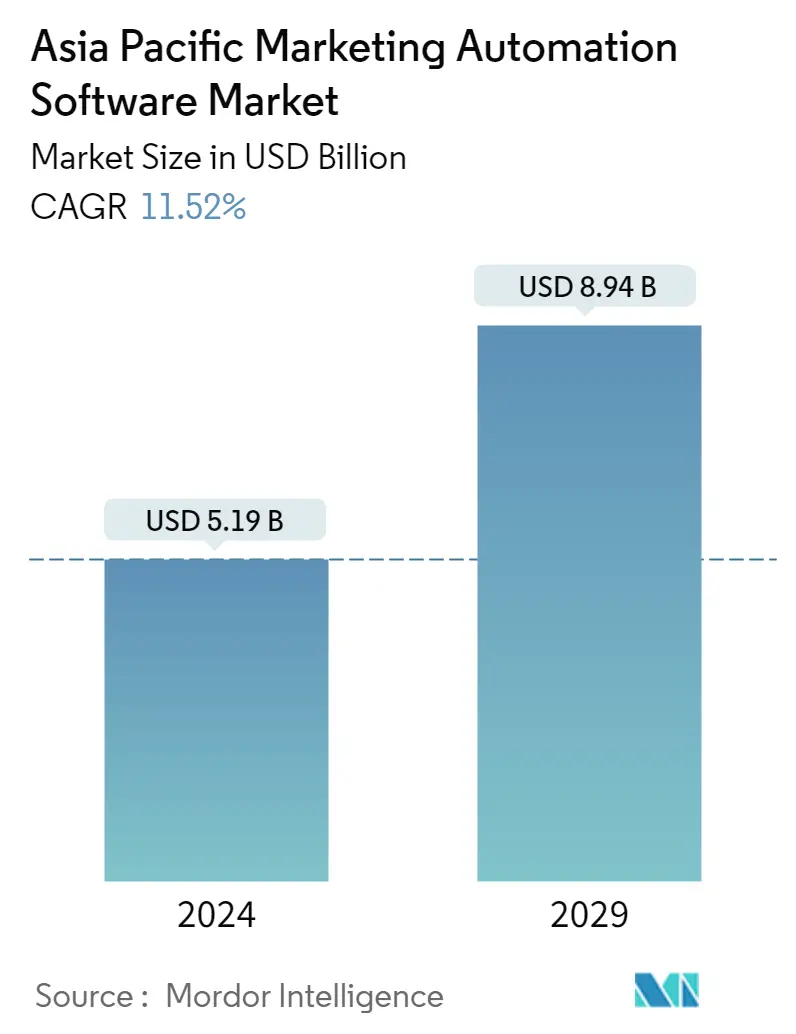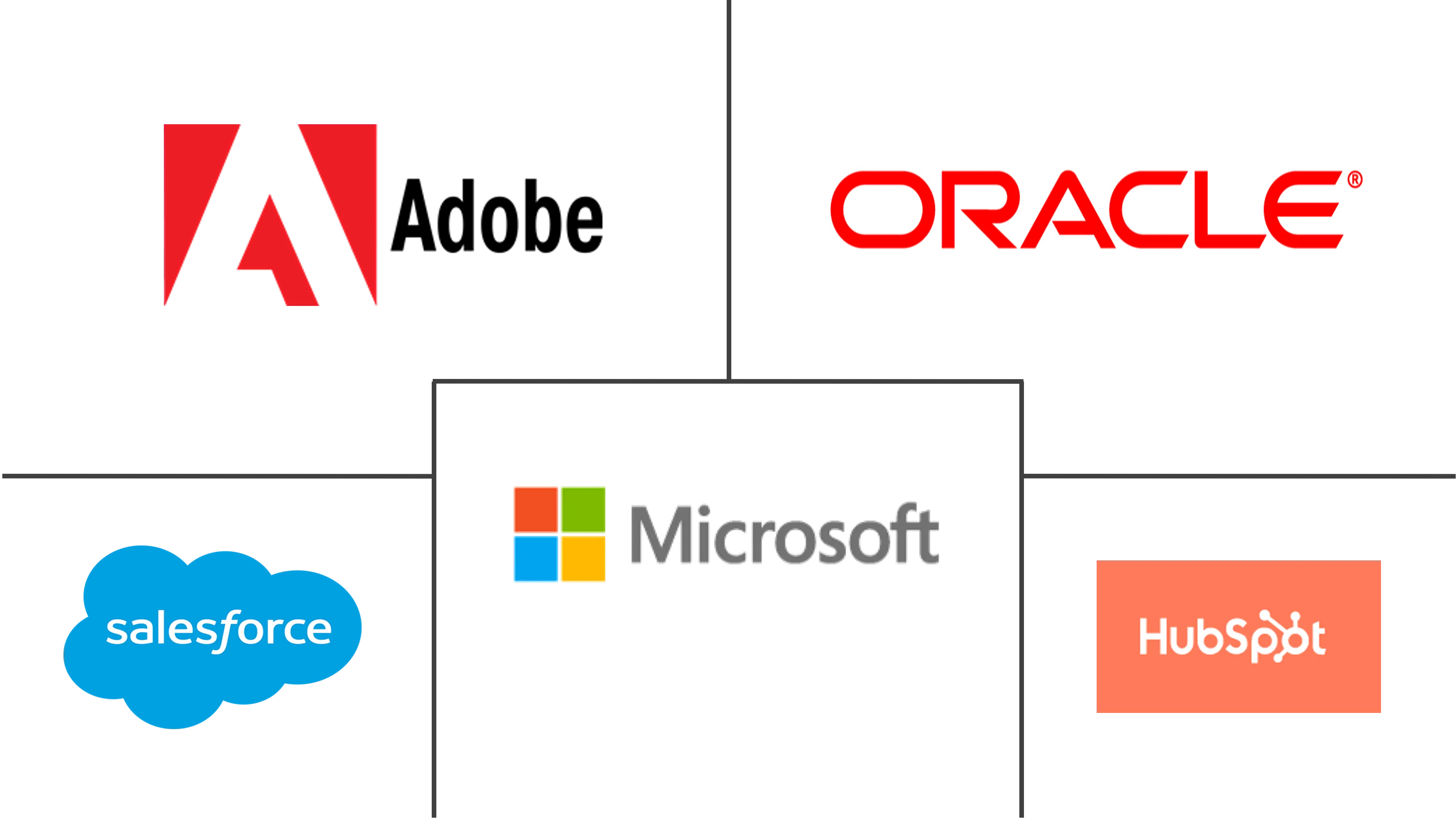Market Size of Asia Pacific Industrying Automation Software Market

| Study Period | 2019 - 2029 |
| Base Year For Estimation | 2023 |
| Market Size (2024) | USD 5.19 Billion |
| Market Size (2029) | USD 8.94 Billion |
| CAGR (2024 - 2029) | 11.52 % |
| Market Concentration | Medium |
Major Players
*Disclaimer: Major Players sorted in no particular order |
APAC Marketing Automation Software Market Analysis
The Asia Pacific Marketing Automation Software Market size is estimated at USD 5.19 billion in 2024, and is expected to reach USD 8.94 billion by 2029, growing at a CAGR of 11.52% during the forecast period (2024-2029).
Marketing automation software can automate typical marketing tasks, eliminating the need for human intervention. Typical marketing automation operations include email marketing, behavioral targeting, lead prioritizing, and tailored advertising. The use of such solutions by E-commerce firms is on the rise, and the market in the region is expected to expand significantly in the near future.
- The growing Internet usage in the area has accelerated e-commerce development, and international corporations such as Amazon have made significant investments due to the region's enormous sales potential. Local businesses such as Alibaba and Rakuten are also making a name for themselves and growing rapidly.
- Australia and New Zealand are embracing technological advancements, with a diverse ICT sector that includes geospatial, telecommunications, payments, agricultural technology, digital content, wireless infrastructure, and healthcare IT. It is expected that such ICT development activities will encourage the usage of marketing automation software in Australia and New Zealand in the future.
- On the other hand, South Korean businesses are choosing from a wide range of cloud computing services, with many industries, including finance, ICT, and healthcare, adopting cloud technology.
- The online gaming business is particularly adopting this technology widely, causing the market for marketing automation software in South Korea to expand. This, combined with the availability of improved connections, well-developed infrastructure, and the growing significance of cybersecurity, is driving growth in the market.
- Marketing automation strives to boost productivity while maximizing a company's time, money, and resources. By automating various tasks such as customer engagement, content development, social media management, lead promotion, market research, and analytics, marketing departments can enhance sales in the future. It also helps to identify each customer's preferences and suggests goods using machine learning and artificial intelligence algorithms running in the background.
- The COVID-19 pandemic caused B2B marketers to divert the majority of their spending away from investing in physical events and toward digital channels, which had a greater impact. Marketers are focusing on campaigns for client retention, lead nurturing, and conversion rate optimization as a result of the pandemic. During the COVID-19-led lockdowns, there was a greater need to access the Internet.
APAC Marketing Automation Software Industry Segmentation
Marketing automation refers to the usage of software to automate marketing activities. Marketing departments are increasingly automating repetitive tasks such as e-mail marketing, social media posting, and even ad campaigns for efficiency and to provide a more personalized experience to their customers.
The Asia-Pacific marketing automation software market is segmented by deployment (cloud-based, on-premise), application (campaign management, e-mail marketing, inbound marketing, mobile marketing, social media marketing), end-user vertical (entertainment and media, financial services, government, healthcare), and geography (China, Japan, India, and the Rest of Asia-Pacific). The market sizes and forecasts are provided in terms of value (USD) for all the above segments.
| By Deployment | |
| Cloud-based | |
| On-premise |
| By Application | |
| Campaign Management | |
| E-mail Marketing | |
| Inbound Marketing | |
| Mobile Marketing | |
| Social Media Marketing | |
| Other Applications |
| By End-User Verticals | |
| Entertainment and Media | |
| Financial Services | |
| Government | |
| Healthcare | |
| Manufacturing | |
| Retail | |
| Other End-User Verticals |
| By Geography | |
| China | |
| Japan | |
| India | |
| Rest of Asia Pacific |
Asia Pacific Marketing Automation Software Market Size Summary
The Asia Pacific Marketing Automation Software Market is poised for significant growth, driven by the increasing adoption of digital marketing strategies across various sectors. The region's burgeoning e-commerce industry, fueled by rising internet usage and the presence of major players like Amazon, Alibaba, and Rakuten, is a key contributor to this expansion. The market is characterized by the automation of marketing tasks such as email marketing, lead prioritization, and behavioral targeting, which are becoming essential for businesses aiming to enhance customer engagement and optimize resource allocation. The rapid technological advancements in countries like Australia and New Zealand, along with the widespread adoption of cloud computing in South Korea, are further propelling the demand for marketing automation solutions. These tools are increasingly being utilized to streamline marketing efforts, improve productivity, and leverage data-driven insights to drive sales.
The market landscape in the Asia Pacific region is moderately consolidated, with both domestic and international players competing for market share. Major companies such as Hubspot Inc., Microsoft Corporation, Oracle Corporation, and Salesforce Inc. are actively engaging in product innovation and strategic partnerships to expand their market presence. The COVID-19 pandemic has accelerated the shift towards digital channels, prompting businesses to focus on client retention and lead nurturing through automated marketing campaigns. Additionally, the region's diverse linguistic and cultural landscape presents both challenges and opportunities for digital advertising, with a strong emphasis on localization. As the online population continues to grow, particularly in China, India, and Indonesia, the demand for marketing automation software is expected to rise, driven by the need for businesses to effectively engage with consumers in an increasingly digital world.
Asia Pacific Marketing Automation Software Market Size - Table of Contents
-
1. MARKET DYNAMICS
-
1.1 Market Overview
-
1.2 Market Drivers
-
1.2.1 Ongoing Shift Towards Digital Marketing
-
1.2.2 Organizations Realizing the Benefits of Data-backed Decision Process
-
-
1.3 Market Restraints
-
1.3.1 Legacy-related Implementation Challenges
-
-
1.4 Industry Attractiveness - Porter's Five Forces Analysis
-
1.4.1 Threat of New Entrants
-
1.4.2 Bargaining Power of Buyers
-
1.4.3 Bargaining Power of Suppliers
-
1.4.4 Threat of Substitute Products
-
1.4.5 Intensity of Competitive Rivalry
-
-
1.5 Assessment of Impact of COVID-19 on the Market
-
-
2. MARKET SEGMENTATION
-
2.1 By Deployment
-
2.1.1 Cloud-based
-
2.1.2 On-premise
-
-
2.2 By Application
-
2.2.1 Campaign Management
-
2.2.2 E-mail Marketing
-
2.2.3 Inbound Marketing
-
2.2.4 Mobile Marketing
-
2.2.5 Social Media Marketing
-
2.2.6 Other Applications
-
-
2.3 By End-User Verticals
-
2.3.1 Entertainment and Media
-
2.3.2 Financial Services
-
2.3.3 Government
-
2.3.4 Healthcare
-
2.3.5 Manufacturing
-
2.3.6 Retail
-
2.3.7 Other End-User Verticals
-
-
2.4 By Geography
-
2.4.1 China
-
2.4.2 Japan
-
2.4.3 India
-
2.4.4 Rest of Asia Pacific
-
-
Asia Pacific Marketing Automation Software Market Size FAQs
How big is the Asia Pacific Marketing Automation Software Market?
The Asia Pacific Marketing Automation Software Market size is expected to reach USD 5.19 billion in 2024 and grow at a CAGR of 11.52% to reach USD 8.94 billion by 2029.
What is the current Asia Pacific Marketing Automation Software Market size?
In 2024, the Asia Pacific Marketing Automation Software Market size is expected to reach USD 5.19 billion.

